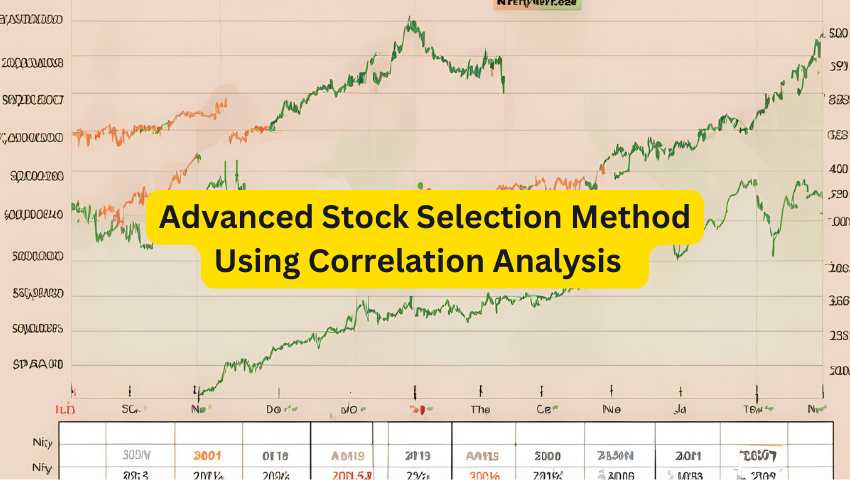
Imagine you’re navigating the stock market, attempting to pick the best stocks for your portfolio. It feels like trying to find a needle in a haystack. This is where correlation analysis steps in, transforming the daunting task into a more manageable and strategic endeavor. Correlation analysis, a statistical tool used to measure the relationship between two variables, can significantly enhance your stock selection strategy.
At Stocksphi, we specialize in utilizing advanced correlation analysis to help traders and investors make informed decisions. By understanding how different stocks move in relation to each other, we help you build a diversified portfolio that maximizes returns while minimizing risk. Let’s dive into how correlation analysis can transform your approach to stock selection.
Correlation analysis involves calculating a correlation coefficient, a numerical value between -1 and 1 that indicates the strength and direction of the relationship between two variables. Here’s a quick rundown:
For example, if stock A and stock B have a correlation coefficient of 0.8, they tend to move in tandem. Conversely, a coefficient of -0.8 suggests that when stock A increases, stock B typically decreases.
In the context of stock markets, correlation analysis helps in understanding how different stocks interact with each other. This understanding is crucial for effective portfolio diversification. Here are a few key points:
Consider the Nifty 50 and Sensex indices. By analyzing the correlation between stocks in these indices, you can identify pairs that move together or against each other, guiding your investment choices.
Understanding the correlation between stocks in your portfolio can significantly enhance your investment strategy. Here’s how:
Consider a portfolio with tech and pharma stocks. Historically, these sectors exhibit low correlation. During a tech downturn, pharma stocks might remain stable or even rise, balancing the portfolio's performance. Stocksphi provides detailed correlation analysis for such scenarios, helping you make well-informed decisions.
Several tools can assist in conducting correlation analysis. Here’s a step-by-step guide using common tools:
For example, using Stocksphi’s tools, you can easily visualize the correlation matrix, highlighting pairs of stocks with significant relationships. This helps in quickly identifying diversification opportunities.
The Nifty 50 index comprises 50 major stocks from different sectors. Analyzing the correlation within this index can provide valuable insights:
By understanding these correlations, you can strategically select stocks to balance your portfolio. Stocksphi offers in-depth analysis and tools to simplify this process.
The Nifty 100 index extends the analysis to 100 stocks, offering more diversification opportunities:
For instance, you might find that FMCG stocks show different correlation patterns compared to financial stocks. Stocksphi provides detailed reports and visualizations to assist in your analysis.
The Sensex index, comprising 30 prominent stocks, also offers opportunities for correlation analysis:
Using Stocksphi’s expertise, you can leverage these insights to optimize your stock selection strategy.
The Nifty 500 index includes a broader range of stocks, allowing for extensive diversification:
For example, combining small-cap and large-cap stocks from the Nifty 500 can offer diversification benefits. Stocksphi helps you navigate this extensive dataset, providing tailored insights for your portfolio.
Utilizing correlation analysis effectively requires advanced strategies. Here are a few methods to elevate your stock selection approach:
Stocksphi offers comprehensive services that integrate these advanced strategies into your investment planning. Our tools and expert analysis ensure you stay ahead of market trends, optimizing your stock selection process.
At Stocksphi, we pride ourselves on our expertise in leveraging correlation analysis to enhance stock selection strategies. Our services include:
Our goal at Stocksphi is to empower traders, investors, and professionals with the tools and knowledge needed to succeed in the stock market. By integrating our services into your investment strategy, you can achieve better risk management and improved returns.
Correlation analysis, while powerful, comes with its own set of challenges. Here are some common issues and how to address them:
By addressing these challenges, you can effectively use correlation analysis to enhance your stock selection strategy and achieve your investment goals.
Q1: What is correlation analysis in stock selection? A1: Correlation analysis measures the relationship between the price movements of different stocks. It helps investors understand how stocks move relative to each other, aiding in portfolio diversification and risk management.
Q2: How can correlation analysis reduce investment risk? A2: By identifying and investing in stocks with low or negative correlations, you can spread risk across your portfolio. This means that if one stock performs poorly, others may not be affected in the same way, stabilizing your overall returns.
Q3: What tools can I use for correlation analysis? A3: You can use Excel, statistical software like R and Python, or specialized tools offered by services like Stocksphi. These tools help you calculate and visualize correlations, making it easier to analyze stock relationships.
Q4: How often should I perform correlation analysis? A4: Regularly updating your correlation analysis is essential, especially during periods of market volatility. Stocksphi provides real-time updates and alerts, helping you stay on top of changing correlations.
Q5: Can correlation analysis be used with other investment strategies? A5: Absolutely. Combining correlation analysis with fundamental analysis, technical analysis, and other strategies can provide a more comprehensive approach to stock selection. Stocksphi offers integrated tools to support multi-faceted investment strategies.
Correlation analysis is a powerful tool that can significantly enhance your stock selection strategy. By understanding how stocks interact with each other, you can build a diversified portfolio that maximizes returns and minimizes risk. Stocksphi is here to support you with advanced tools, expert guidance, and comprehensive resources, ensuring you make informed and strategic investment decisions.
Whether you're a trader, investor, learner, technologist, or professional, leveraging correlation analysis through Stocksphi can transform your approach to the stock market, helping you achieve your financial goals.
Ready to enhance your stock selection strategy with correlation analysis? Visit Stocksphi today to access our advanced tools and expert services. Start making informed investment decisions and achieve your financial goals with confidence.